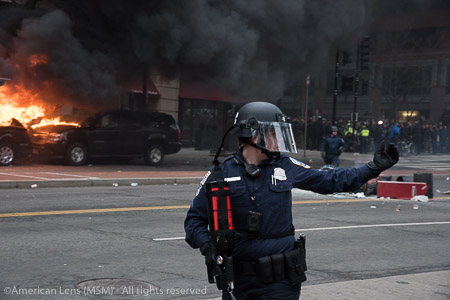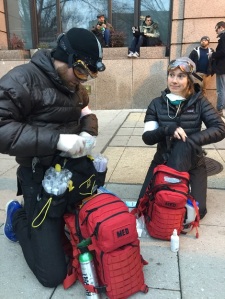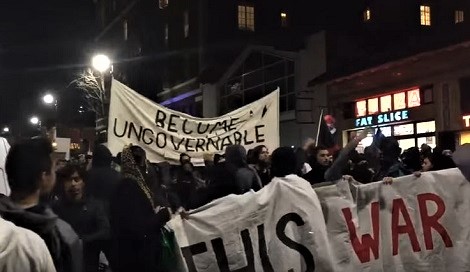Black Bloc: an informal grouping of militant, mainly anarchist, protesters who act together during anti-capitalism, anti-war, etc, protests, often wearing black hoods and black clothing.
This is the definition in most dictionaries. It’s mainly a physical description that lacks historical context and is a white-washed mockery of their violent activities. They are one component in what we at American Lens call the “National Uprising.”
Origins
There are differing opinions on when the term Black Bloc was first used and its original roots. Most consider certain events in Germany to be the true point of origin, but a few point as far back at the Haymarket Square Affair in Chicago which took place on May 3, 1886.
The Haymarket Affair, as it would later be called, was a two-day long battle between anarchist protesters and the police which included at least one bomb being thrown at a police station.
Documentation on the Haymarket Affair is scant, but what is known is that at least one civilian died, but there were reports that up to four civilians died. Seven police officers were killed during that two-day period and later eight anarchists would be indicted for deaths of the police officers.
The consensus is that the real roots of Black Bloc can be traced to violent protests that took place surrounding the eviction and arrest of anti-nuclear protesters by police in Germany between 1977 and 1980.
Specifically, in Brokdorf, Germany (1977) where tanks and water cannons had to be employed to remove protesters and a few years later in Gorleban, Germany (1980) when police evicted thousands from a camp called the ‘Free Republic of Wendland‘. The town of Gorleban continued to see protests and violence as late as 2010.
The Wendland camp was an anti-nuclear blockade that was established in May of 1980. The town was chosen due to a nuclear waste facility which was to be built outside of the town the year earlier. The camp was very similar to that of the Occupy movement, which began in 2011 and died out a year later.
Depending on which source one reads, the eviction included removing anywhere from 3,000 to 5,000 people. The German authorities began the process in June of 1980 and officers ended up having to carry out protesters who refused to move.
Again, depending on the source you read, the eviction either went peacefully or it was a violent clash. Regardless of what really happened, the Wendland protesters used the eviction to call for protests employing violent methods.
The Wendland eviction and subsequent waves of mass arrests by authorities triggered protests in various Germany cities. One protest in Berlin had as many as 20,000 protesters, who proceeded to destroy a shopping complex.
The name ‘Black Friday’ was given to the incident and it was essentially a riot. Protesters had dressed alike in dark clothing and had covered their faces to evade arrest. It is here that Black Bloc seemingly emerged.
Ideology & Purpose
Modern Black Bloc ideology is based on a blending of Anarchism and Marxist-Leninist theories. Black Bloc, being rooted in a hybrid of anarchism and Marxist-Leninist, believe that all government is slavery. Freedom can only be achieved through anarchy.
The Marxist portion seems to draw from what was known as Autonomism or Autonomist Marxism. Autonomism includes anti-capitalist, anti-authoritarian themes and class struggle is its core.
Autonomist Marxists believe that the working class can go around unions, political parties, and state entities to effect change. This form of Marxism employs tactics like sabotage in the workplace, property damage and encouraging skipping work as methods to ‘fight capitalism’. This type of Marxism, like all other forms of Marxism, failed not long after it sprang up in Italy and France during the 1960’s.
According to a document called the Black Bloc Papers, written by anarchists David Van Deusen and Xavier Massot, Black Bloc believes its purpose is to be a tool through which any given protest is ‘escalated to the next level’.

Protesters including Black Bloc and Antifa set a limo on fire in Washington, D.C. – Image via American Lens News
By ‘next level’, Black Bloc believes that by employing violent tactics such as assault, arson and destroying property, it is the government or state that will end up being exposed as the real perpetrator of violence.
During the violence in Washington, D.C., a limousine was attacked and set on fire by protesters, some of whom were likely affiliated with DisruptJ20 and Black Bloc.
Property damage and related violence are the tools through which Black Bloc attempts to control protests through intimidation and by inciting fear. Let’s not white-wash what Black Bloc’s real function is – to incite terror.
The Black Bloc Papers details 31 separate actions that took place between 1999 and 2005. The list starts with “The Battle of Seattle/N30: The Anti-WTO Protests” (1999) and runs through “Back In Black: Inauguration Day” (2005).
A well-known prior example of violent and confrontational Black Bloc tactics being employed is that of the Weather Underground in the early 1970’s.
Weather Underground was a radical offshoot of the Students for a Democratic Society (SDS) whose members include Bernadine Dohrn and her husband, Bill Ayers, who is a noted friend and neighbor of former President Obama. Both are still active today, supporting radical groups from Occupy Wall Street to Black Lives Matter to Black Bloc.
The Weather Underground formed for the express purpose of overthrowing the U.S. government and were responsible for multiple bombings of government buildings in the 1970’s – including the Capitol, Pentagon, and State Department.
Military-style Tactics and Organization
Black Bloc is not a randomly occurring phenomenon. They are organized and trained in a military-style fashion.
Every event where Black Bloc has shown up was coordinated and participants all belonged to a sort of squad they refer to as an “Affinity Group”. Each Affinity Group has a responsibility and position to cover during the protest and ensuing riot.
They employ a platoon-like hierarchy structure that includes what is referred to a “general tactical facilitation core” org-tacs for short. The g-tacs are the Black Bloc members in charge on the ground of their particular Affinity Group.

Protesters in D.C during the inauguration of Donald Trump, gear is stowed but readied for tear gas and other problems spurred by Black Bloc led violence.
Image via American Lens News
Affinity groups are made up individuals with set directives and roles, such communications, medical aid and of course, those concentrating on property damage, vandalism and engaging law enforcement.
The g-tacs set themselves up near the perimeter of the action with one or two members of their Affinity Group close by for support.
In this way, the g-tacs is much like a general sitting on the edge of the battlefield directing attacks, conducting reconnaissance and relaying intel to their troops.
The various Affinity Groups are given assignments and positions to cover. Often several separate Affinity Groups will be positioned together in a “cluster.”
Black Bloc participants train on their own and in groups.
One individual who is known for training such groups as Black Bloc and later, Labor Unions, is Lisa Fithian.
Fithian has a long history with Black Bloc and was one of the main organizers of the violent demonstrations at the 1999 WTO meetings in Seattle.
Notably, Fithian was the lead trainer and organizer in Ferguson, Missouri after the Michael Brown shooting took place. Fithian spent weeks being paid to teach locals how to ‘simulate of chaos’. On November 24, 2014, the verdict came back, there would be no indictment. With Fithian’s aid and on cue, violent riots broke out in Ferguson.
Her handiwork can also be found from Black Bloc actions related to Occupy Wall Street to the Anti-Trump/Milo Berkeley riot to the Black Bloc riots in D.C. during the inauguration, which resulted in hundreds of arrests.
Despite the arrests, Black Bloc is likely undeterred and we have not seen the last of them.





You must be logged in to post a comment.